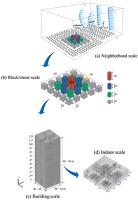Journal of Wind Engineering and Industrial Aerodynamics ( IF 4.2 ) Pub Date : 2021-04-30 , DOI: 10.1016/j.jweia.2021.104645 Peng-Yi Cui , Yan Zhang , Wei-Qiu Chen , Jin-Hao Zhang , Yang Luo , Yuan-Dong Huang

|
The diffusion of air pollutants in urban areas is essentially a multiscale problem, which has aroused increasing concerns. Wind-tunnel experiments were employed to explore the characteristics of indoor/outdoor airflow and pollutant exchange in a building cluster. Under two wind directions (β = 0°,45°), smoke visualization tests were firstly conducted to visualize the diffusion characteristics of air pollutants released from different pollution sources. Then the 3D hot-film anemometer and SF6 quantitative detector were used to measure the turbulence parameters and pollutant distributions. The smoke visualization tests showed that under β = 0°, the pollutants were mainly concentrated in the middle main street canyons (S-1 and S-2), spread downstream, and were gradually diluted. However, the influence area under β = 45° was wider. The results confirmed that the indoor pollutant concentration along different floors was closely related to that around the outside target building. The window-opening mode had great influence on indoor pollutant concentration, but little influence on the other floors. Additionally, when the pollution source was located in the building leeward wake, regardless of the building height, it could reduce the indoor air quality of the leeward building. This study is helpful to understand the characteristics of flow and dispersion through different urban scales.
中文翻译:

风洞研究建筑群室内/室外气流和污染物交换的特征
空气污染物在城市地区的扩散本质上是一个多层面的问题,引起了越来越多的关注。利用风洞实验来探索建筑群中室内/室外气流和污染物交换的特征。在两个风向(β = 0°,45°)下,首先进行了烟气可视化测试,以可视化从不同污染源释放的空气污染物的扩散特性。然后使用3D热膜风速计和SF 6定量检测器测量湍流参数和污染物分布。烟雾可视化测试表明,在β之下 = 0°时,污染物主要集中在主要街道中间峡谷(S-1和S-2),向下游扩散,并逐渐被稀释。但是,β = 45°以下的影响范围更广。结果证实,不同楼层的室内污染物浓度与外部目标建筑物周围的污染物浓度密切相关。开窗模式对室内污染物浓度影响较大,而对其他楼层影响很小。另外,当污染源位于建筑物的背风尾流时,无论建筑物的高度如何,都可能降低背风建筑物的室内空气质量。这项研究有助于了解不同城市规模的流量和分散特性。











































 京公网安备 11010802027423号
京公网安备 11010802027423号